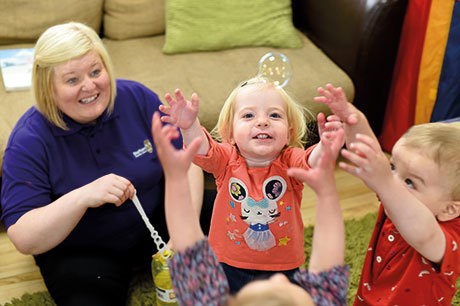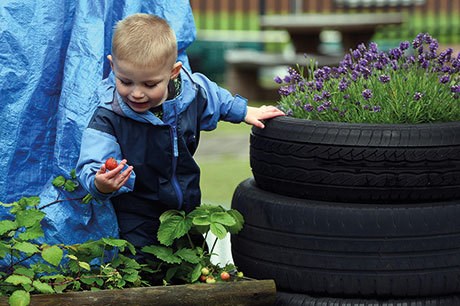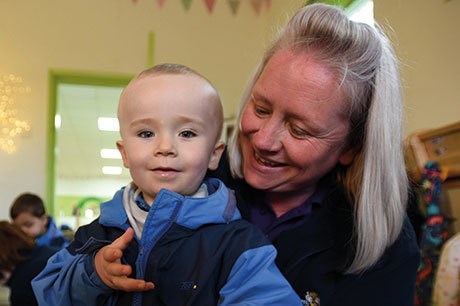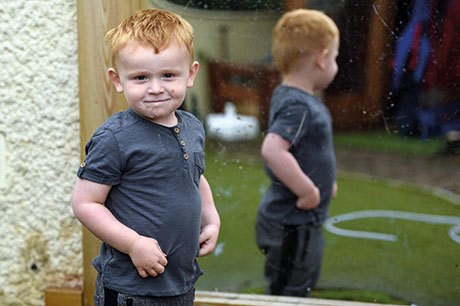EYFS Best Practice: All about… children’s rights
Ruth Thomson
Monday, September 4, 2017
What children’s rights are legally, and how they should be promoted. By Professor Priscilla Alderson

Alan, aged five, enjoys going to school, where he is pleased to be starting to read, he sees his friends, the building is warm, and he has free school meals. But his wheelchair is broken and he has been waiting at home for weeks for it to be mended. His parents have to take turns missing work to be with him, and they cannot afford to have the heating on much, or to have regular meals.
Alan’s case raises vital questions, among them: What are children’s rights? Are they respected? And if not, do they have any value? When do children begin to have rights? All questions that I will seek to answer.
Children’s rights are not popular with everyone, nor are they well understood. To some, children’s rights are vague, for others they are too complicated. Many people dismiss the need for a raft of children’s rights – ‘Children don’t need rights! They cannot understand them!’; or question their relevance – ‘How is the right to a home relevant for wealthy children in the UK?’
There is also the concern that raising children’s awareness of their rights might instil in them a sense of entitlement and selfishness. Critics say, ‘They’ll think they can do whatever they like’; ‘Children need to learn not to be selfish, and how to care about other people. Rights don’t teach them that.’
Children’s rights are more likely to be overlooked or dismissed by adults whose own rights are not respected. Some adults working in early years services may receive low pay and little thanks for their stressful work, with its pressures to keep children safe and abide by many written and unwritten rules. Talk of children’s rights can seem like still more rules for adults to obey, giving adults still less movement and creative choice about how they work with children and care for them.
Yet it is vital that those in the early years sector understand, respect and promote children’s rights. Rights are central to everyday life and relationships, affecting every child and family wherever they may live. Rights are remedies for wrongs and tools for change.
While Alice was down the rabbit hole in Wonderland, she spent some time in a dark hall with doorways too small for her to pass through. She longed to find the doorway that opened onto a garden. Rights can be the keys to open the door to the sunlit garden for everyone to enjoy freely.
RIGHTS: DEFINED
The United Nations 1989 Convention of the Rights of the Child (UNCRC) defines children’s rights. Too often, people refer only to Article 12: the child’s right to form and express views. But it is important to read the rich detail within all 42 of the UNCRC’s main Articles.(1) These can be divided into three partly over­lapping types.
Point for reflection
As you read the rights, think about which, if any, you think young children, like Alan, should not have.
1. Provision rights
- A child has the right to:
- the basic care necessary for the child’s well-being
- healthcare, clean drinking water and nutritious food
- education
- an adequate standard of living and housing, with support from the state when it is necessary to enable the family and community to assure these rights.
Living and learning
Provision rights are about providing for basic needs, not luxuries, and they involve high aims. Education rights, for example, include children being able to ‘develop their mental and physical abilities to their fullest potential’ and to develop respect for their parents and for their ‘cultural identity, language and values’ (UNCRC, Article 29).
When children learn to respect equal rights, they are prepared ‘for responsible life in a free society, in the spirit of understanding, peace, tolerance, equality of sexes, and friendship among all peoples’ (Article 29).
Because no-one’s rights should override anyone else’s, babies, for example, do not have the right to be breastfed and mothers should not be forced to do so. Instead, everyone has the healthcare rights to be ‘informed, have access to education and [be] supported in the use of basic knowledge of child health and nutrition, the advantages of breastfeeding, hygiene and environmental sanitation and the prevention of accidents’ (Article 24e).
Critics of the UNCRC assume that a ‘free society’ involves lonely selfish autonomy, a ‘Western’ model of isolated individuals. They say this model does not fit most countries, such as those in Africa and Asia, where many children live in close extended families and communities.
Yet the UNCRC is not about freedom from other people. Rights are for freedom against being exploited, coerced, enslaved or ruled over by unjust governments, and to live and learn together in peace and justice.
2. Protection rights
A child has the right to be protected against:
- abuse, neglect, negligence, torture or other cruel inhuman or degrading treatment
- invasion into children’s privacy and family life
- discrimination
- exploitation or harmful interference with the child’s health or development
- illicit drug use, sexual abuse, the sale or traffic of children
- unlawful imprisonment.
- States should also ensure the protection and care of children who are affected by:
- separation from their family
- armed conflict
- migration and asylum-seeking.
Reasonable and realistic
Critics complain that the UNCRC wording is too complicated. However, the UNCRC, like the United Nations 1948 Universal Declaration of Human Rights and other great UN conventions, has been carefully worded by lawyers so that rights are reasonable and realistic and can be defended against critics.
For example, no-one has a right to be loved or to feel safe, because these are feelings that cannot be willed (switched on or off) or enforced. Parents cannot be taken to court and ordered or made to love their baby. But courts can order actions to defend children from being neglected or abused by their parents/carers.
3. Participation rights
A child has the right to:
- respect for the child’s worth and inherent human dignity
- life and survival
- a name, legal identity and nationality
- contact with family, and help with reconnecting the family after enforced separation during armed conflict or migration
- rest, leisure, play and recreation
- take part in cultural life and the arts
- express views freely in all matters affecting the child
- freedom of expression and information
- freedom of thought, conscience and religion
- freedom of association and peaceful assembly
- respect for the child’s cultural background
- due legal process.
Disabled children also have the right to help to ‘promote self-reliance and… active participation in the community’ (Article 23).
Civil rights for all
Children and adults share largely the same rights, with participation rights being children’s versions of adults’ original freedom or civil rights. We all have rights to education and to rest and leisure. Freedom of ‘association’ and ‘peaceful assembly’ (Article 15) mean the right to go freely in any public spaces, to meet friends and join peaceful groups.
RIGHTS: ILLUSTRATED
Some of the above children’s rights might look pointless, but each item is crucial. One case that has shown the relevance of children’s complex rights is that of Charlie Gard. As we learned from many media reports, Charlie was born with severe problems and by a few months old could not see, or drink milk or breathe unaided. Doctors said it was cruel to respect his right to life because he was too brain-damaged and extremely disabled. His condition would only worsen and he was in such pain that his life could only be a burden to him. He should no longer be kept alive by machinery, but be relieved from his suffering and allowed to die. Charlie’s parents wanted everything to be done to keep him alive.
In April, a High Court ruling stated that doctors could withdraw Charlie’s life-support treatment – against his parents’ wishes. The judge had to decide on Charlie’s best interests by weighing Charlie’s right to life against his right to develop (he was too disabled), to be free from a life of suffering and free from cruel treatment (meaning painful treatment that cannot heal the problems), and to be allowed to die in dignity. In late July, Charlie’s parents finally ended their legal fight over his treatment.(2)
The following examples also illustrate how problems can happen to ‘ordinary’ families like Charlie Gard’s.
Point for reflection
As you read, check the earlier lists of rights to see how many relate to each case study.
Leila’s children
Leila’s ex-partner broke in and trashed her flat. The landlord accused Leila and her two young children of damaging his property. He evicted them, and sent a bill for repairs of £15,000. Social services wanted to remove the children from a ‘dangerous, violent mother’ and they would not help the family find a new home. In recent years, the British Government has cut legal aid by hundreds of thousands of pounds. So, Leila could get no legal help at all when she was in court trying to keep her children and prove her innocence.
Kwame
Kwame, aged four, lives in rural Ghana. He loves helping his older brothers and friends herd the goats as they wander over the land, play and fish in the river, and then cook fish over a camp fire. His family have lived there as long as they can remember. Yet one day they are told a company has bought the land, and they will have to leave. The family seem to have no choice but to try to find somewhere to live in the nearest city.
Jasmine
When she was four, Jasmine developed Type I diabetes. She needed to have a finger-prick blood test and an insulin injection twice every day, and she hated having needles stuck into her. To avoid having constant battles, her parents had to make sure that Jasmine understood why she needed the injections. They gave her information and listened to her views and worked out with her the best way to manage her diabetes care. Jasmine found she preferred to do the injections herself, and to feel she had some control.
RIGHTS: FROM BIRTH

The rights of older children tend to be more respected, but do babies have rights?
All three types of rights outlined above begin from birth. ‘Education’ involves the baby’s own constant learning and the education of the caring adults. The better educated mothers are, the healthier their children tend to be. When each baby has ‘a name, legal identity and nationality’, the government can recognise the child as a citizen with the right to the children’s services and protections that the state provides.
Participation rights are less often seen as babies’ rights, but these too can begin from birth. ‘Discrimination’ can harm babies as much as adults when their parents are denied equal rights; for example, to use public transport to get to work.
Article 12 states that ‘the child who is capable of forming his or her own views [has] the right to express those views freely in all matters affecting the child, the views of the child being given due weight in accordance with the age and maturity of the child’.
Babies are developed and ‘mature’ enough to form and express views about when they are hungry, tired, contented, bored or afraid. And adults can care well for babies only when they listen to babies’ views strongly expressed through their cries and smiles. Gradually, young children learn to make complicated decisions, as in the case of Jasmine.
When aiming to respect the very varied cultures of childcare around the world, and to break free of prescribed and imposed Western standards, Martin Woodhead dismissed many claimed needs and rights.(3)
Apart from milk and hygiene, babies’ supposed ‘needs’, he thought, depend on local cultures and are not essential, so babies do not ‘need’ adults to provide them, for example, with music. Yet babies are very complex human beings. Music is part of their life, from hearing their mother’s heartbeat onwards. They nod and sway to dance music, are cheered by songs, soothed by lullabies, and soon start clapping and singing. They need to do music, they cannot help it. The UNCRC reflects the complex range of babies’ needs.
RIGHTS: ON FOUR LEVELS
Children’s rights become all the more real, and relevant – as in a baby’s need for music – when we think of rights, not as a seemingly endless list, but on four levels: physical, psychological, relational and within systems.
Physically
Nearly all provision, protection and participation rights are expressed through bodies – in how bodies are respected or confined, nurtured or neglected, fed or starved, harmed or healed, included or excluded, honoured or punished, attended to or ignored.
Psychologically
We all have deep longings for justice, respect and kindness, the principles on which rights are based. In their second year, children start saying, ‘It’s not fair’, ‘My turn, your turn’, ‘Let’s share’.
Paul Bloom showed films to babies of puppet-like shapes: some were helpful and others were unhelpful. He filmed and analysed babies’ responses of attention and surprise. Babies from three months old seemed to judge the goodness and badness of the puppets actions, and soon the babies showed empathy and compassion. They tried to soothe those in distress. They showed an early sense of justice, by six to ten months, when they reached for the helper puppet more often than the hinderer puppet.(5)
Rights are shared in solidarity, interdependence, kindness and equality: ‘our rights’, not ‘my rights’.
In relationships
We seem to be aware from birth of mutual respect between people, which is at the heart of rights. Research has found that from only two hours after birth, if someone looks at babies with a rigid, passive face, the babies become distressed, avert their gaze and eventually start crying, though they calm down when the researcher starts smiling.
However, if this happens a second time, babies gaze and try to make contact for longer before getting upset, and they recover more quickly when the researcher starts smiling again, as if they learned from the first time and are trying to have more control over the contact.(5)
Black and white young children, disabled and able ones play easily together without discrimination. Gradually, their relationships become much more complex. Children are influenced by adults and other children in how they strengthen and deepen their early sense of respect and justice, or not. But in all our relationships we cannot avoid either respecting or disrespecting other people’s rights.
In international systems
Children’s and adults’ provision, protection and participation rights slowly emerged through centuries of oppressed people protesting and fighting for justice. Over the past 400 years, rights have been carefully coded by philosophers and lawyers into powerful statements that today’s governments, courts and public services endorse. Gradually, the ‘rights of elite men’ were extended to all other adults and to children.
The United Nations enshrined these rights in a series of conventions, such as the UNCRC. They asked every government to ratify the UNCRC (they all did except the USA), which means that they promise to implement all the rights and report to the United Nations regularly on their progress in doing so.
Rights, therefore, really exist as powerful statements in agreed policies and laws and international treaties (like the UNCRC). The repeated wording through the UNCRC – ‘States parties shall assure…’ – makes each Article a promise that state parties, the governments, undertake to keep. So, rights also exist in their lasting influence and the effects they have on the lives of children and adults.
SOLVING PROBLEMS AND PROMOTING RIGHTS
Despite the careful coding of rights over centuries, rights are still too often ignored and violated, as the suffering of children around the world shows.
Sometimes, there is also the problem of deciding which right should take priority over others, as in Charlie Gard’s case. Four UNCRC Articles set useful guiding principles:
Article 2: Non-discrimination and equal respect for all children.
Article 3: ‘The best interests of the child shall be a primary consideration.’
Article 6: The right to life and ‘to the maximum extent possible the survival and development of the child’.
Article 12: Respect for the views of the child. Ultimately, we need to remember that the more rights seem absent, the more important and urgent they become. The right to nutritious food matters little to wealthy, well-fed children but greatly to malnourished and starving children.
- The precious rights of young children and of the adults who care for and work with them are promoted when all the adults concerned:
- read the original UNCRC
- check false criticisms against the UNCRC
- base planning, policies and practice on the UNCRC when providing services, inspections, and training and support for staff
- know how to help families to appeal if their rights are denied.
Then rights can help to work as the keys to open the door to the sunlit garden of peace, freedom and justice for everyone to enjoy equally.
REFERENCES
1 UN Convention on the Rights of the Child, www.ohchr.org/EN/ProfessionalInterest/Pages/CRC.aspx
2 ‘Parents of Charlie Gard agree he will spend final hours of life in hospice’, www.theguardian.com/uk-news/2017/jul/26/charlie-gard-can-be-cared-for-in-hospice-his-parents-tell-court
3 Woodhead M (1997) ‘Psychology and the cultural construction of children’s needs’, in James A and Prout A (eds)Constructing and Reconstructing Childhood. Routledge
4 Bloom P (2014) Just Babies: The Origins of Good and Evil. Broadway Books
5 Newborn baby development study, http://theconversation.com/newborn-baby-development-has-been-vastly-underestimated-our-study-shows-81972
Priscilla Alderson is Professor Emerita of childhood studies at University College London. Her books includeYoung Children’s Rights (2008, Save the Children/JKP). Childhoods Real and Imagined (2013, Routledge) is about new ways of understanding babies and children, andThe Politics of Childhoods Real and Imagined (2016, Routledge) is about major global problems facing children and young people, and how they might work with adults to change the world.




